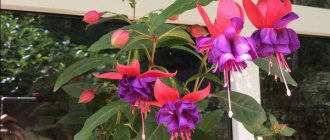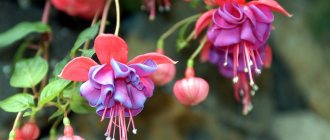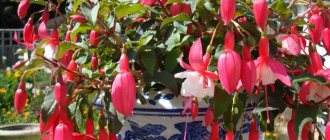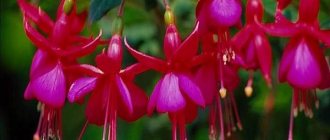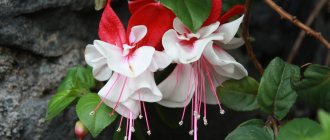Description of fuchsia with photo
First of all, I would like to say that the Fuchsia genus includes approximately one hundred species of plants that belong to the Fireweed family. Its representatives live in the mountain forests of America, and are also found in Mexico, Argentina, Tahiti, New Zealand, Chile, Peru and the Falkland Islands. Under natural conditions, the plant always lives in partial shade, under the canopy of trees.
The leaves of the plant are opposite; their shape can be either lanceolate, ovate, serrate, or crenate or entire. The fruits of the plant are quite juicy, and somewhat resemble berries. The appearance of Fuchsia is either bushy or creeping. It has graceful flowers on thin stalks, which differ in different colors.
The main feature of fuchsia that gives it the greatest grace is the long, brightly colored stamens protruding outward and the prominent pistil style. All this makes the plant a unique creation.
Types of fuchsia
Dozens of fuchsia varieties are suitable for home cultivation. But to make it easier for you to navigate, we have selected the most popular types!
Three-leaved fuchsia
This is a neat bush up to 60 cm, which is well suited for hanging. Slightly drooping leaves up to 8 cm long have a reddish color, and the flowers look like scarlet bells.
Sparkling fuchsia
One of the most decorative varieties with spectacular serrated leaves and fancy-shaped pink-violet flowers. The fruits formed after flowering are even edible.
Bolivian fuchsia
The species is interesting primarily because the flowers are collected in huge fancy clusters on an equally impressive peduncle up to 30 cm in length. The most common varieties are red and white.
Recumbent fuchsia
A compact creeping species that landscape designers use to design areas. Bell flowers in all shades of pink and orange always reach for the sun.
Thyroid fuchsia
An elegant and tall bush can often be found in offices and shop windows. Flowering lasts until October, and the elongated buds of pink and purple shades are collected in brushes.
Magellan fuchsia
A tall garden bush that grows up to 3 m and is densely covered with flowers from spring until autumn. It tolerates low temperatures well and, when pruned, can even winter on a glazed balcony.
Graceful fuchsia
Large, showy flowers are held on such thin stalks that they seem as if they are floating in the air. Even in indoor conditions, a flower can grow up to 1 m, and in a natural environment - several times more.
Ampelous fuchsia
A very popular category combines varieties with flexible, cascading shoots. It is especially beautiful in hanging pots with its clusters of buds resembling little lanterns.
Calibrachoa (60 photos): types, planting and proper care
Types and popular varieties
Over a fairly long period, many types of fuchsia have been bred. This article will only talk about a few.
Fuchsia hybrid
An upright or hanging shrub. It has quite bright flowers, which are distinguished by their large size. A distinctive feature of this variety of fuchsia is its differently colored cups and petals. This species has a large number of varieties. Among which are:
- Litte Bell, since the flowers of this variety somewhat resemble bells;
- Cecile - the shape of the flowers is reminiscent of the skirts worn in the fifties;
- Swingtime – the flowers resemble some unknown overseas birds.
Fuchsia hybrid
Fuchsia trifoliata
It is considered a rare type of fuchsia. A distinctive feature is the presence of rhizomes, elegant large foliage with a reddish-green color, short inflorescences, and finally, bright coral flowers. The fuchsia variety is quite hardy. Varieties: Bacon, Constance, Garden News. These varieties are winter-resistant and can be kept either in little or no shelter, or under snow.
Fuchsia trifoliata
Most common varieties
Many modern varieties are characterized by bright color combinations.
Fuchsia Blue Vale
This is a universal variety; it can be grown either as a bush or as an ampel. The snow-white sepals of double, large flowers have a green tint along the edge. The flower's skirt is fluffy and lavender in color.
Flowering is long lasting and very abundant.
Fuchsia Bella Rosella
The plant has some of the largest flowers (10-12 cm). They are terry, bright, lilac-pink with snow-white stamens and pale pink sepals. Flowering is abundant and long lasting.
Fuchsia variety Bella Rosella has an ampelous and bush form. It is unpretentious and can grow in shade.
Variety Bella Rosella
Fuchsia Blue Angel
Blue Angel variety is an exquisite, memorable fuchsia. The flower size is up to 12 cm in diameter. The corolla (skirt) of the flower is double dark lilac in color, the sepals are white. When fully bloomed, white stamens with pink anthers become a spectacular accent. The bush is semi-ampelous (drooping).
Fuchsia Hollis Beauty
The flowers are large (7-8 cm), double, white sepals, lilac-blue skirt. The bush grows very neatly, has a compact shape, and branches well. The variety tolerates heat and bright sun better than other fuchsias.
The flower is elegant, contrasting, white-green sepals set off the purple-pink skirt. Especially good in full dissolution. Pink elongated stamens set off milky white anthers.
Important! The growing form is ampelous, the lashes of an adult plant grow up to 60 cm in length
Fuchsia Blue Ice
The plant was obtained as a result of the starting mutation of the Dark Eyes variety in 1954 in the United States of America. Large, double flowers are distinguished by a characteristic arrangement of petals. They resemble a multi-layered petticoat. The color of the petals is deep lavender, the sepals are light crimson. It is interesting that in plants of this variety, flower petals can vary in color intensity. The variety is undemanding; it is grown in bush and hanging forms. Grows quickly, restrictive pruning is recommended to form a dense crown. Feels good in partial shade.
Fuchsia Bicentennial
Fuchsia ampelous Bicentennial is painted in salmon-orange tones. The characteristic magenta strokes along the edge of the multi-layered skirt create an extraordinary color contrast. The flowers are elongated, rather large, in the form of buds. Light sepals become bright orange over time.
The variety was bred by Californian gardener Ted Pasquesen in 1976 and dedicated to the 200th anniversary of US independence. Paskesen carried out lengthy breeding work to obtain a variety that was resistant to heat and strong winds.
The plant forms a dense, branching crown and blooms profusely.
Variety Blue Mirage
Fuchsia Blue Mirage
The plant can be grown as a semi-mounted plant, in the form of a drooping bush and in hanging containers.
Blue Mirage is a large-flowered variety that blooms with deep purple flowers with snow-white sepals. The length of the shoots of the variety is up to 40 cm. Flowering is early, abundant, and long-lasting. The flowers are double and large.
The leaves are medium in size, the stems become woody quickly, so the variety is easy to grow in standard form. The variety is fast growing and winters well. Suitable for growing by beginning gardeners.
Fuchsia Cecile
The flowers are large, double, and have a bright, unusual combination of shades. The wavy, layered petals are lavender blue and the sepals are dark pink. Fuchsia variety Cecile is grown in bush and hanging form.
Vessel
The unique purple-pink color has become the hallmark of the flower; it is not without reason that one of the first synthetic dyes, fuchsin, received its name.
The ships of the Japanese company ONE (Ocean Network Express), which is engaged in sea container transportation, cannot be confused with others. Their signature color is fuchsia.
Photo 7 Motor ship "Fuchsia"
The no less “glamorous” pleasure catamaran “Fuchsia” plies along the Moscow River.
Caring for fuchsia is easy. If you create optimal conditions for the plant, elegant lantern flowers will create a bright mood for many years.
How to grow fuchsia from seeds
Preparing soil and seeds
Land preparation. There is an option to purchase special soil in the store, or you can make it at home. To do this, take three parts of turf soil, two parts of peat, one part of sand. Place the soil in a container and moisten it, spray it with a weak solution of potassium permanganate, and try to compact it well.
Seed preparation. You can buy seeds in a special store, or you can get them yourself. Carry out pollination: transfer pollen from the stamen of one flower to the pistil of another. Cover the pollinated bud with a bag and wait until the fruit (small berry) grows. When it appears, remove the cover and wait until the berry turns purple. After this, collect the fruits, carefully collect the seeds from it, dry it, and put it in bags.
Sowing
Seeds should be sown on the surface of the soil that you have previously prepared. Do not cover them with soil, as is often customary. A slight pressing of the seeds into the ground will be enough.
Very important! The pressure should be light, as the seeds need light to sprout. But, if you still decide to sprinkle it with earth, do it very symbolically.
Seedling care
The container with seedlings should be covered with polyethylene or glass. After this, it is important to move the future plant to a warm, bright place, protected from direct sunlight. Maintain the temperature in the area that is best for seed germination. This is approximately eighteen to twenty degrees Celsius. If condensation occurs, ventilate the seedlings.
Pay attention to soil moisture; it should not be waterlogged. If the soil suddenly dries out, spray with water. Sprouts will appear in twenty or thirty days. After this, ventilation should be carried out more often, gradually increasing the time.
After the second pair of full-fledged leaves appears, pick. Try to feed the seedlings with mineral fertilizers once every two weeks. When the height of the sprouts reaches ten centimeters, pinch the top.
Reproduction
The practical actions of many gardeners have proven that the simplest and most effective way to propagate fuchsia is to root cuttings. The latter are obtained by pruning bushes after wintering; accordingly, the propagation process should begin in early March.
There are 3 options in total:
- cuttings;
- leaves;
- seeds.
Cuttings
The cuttings obtained after pruning must be rooted. The best nutrient medium is plain water, but some varieties feel better in soil mixed with sand, peat and a universal mixture.
Next, observation is carried out for 10-15 days. If the shoot has sprouted new roots, it is necessary to continue observation for another 5-7 days, after which the flower is transplanted into a pot.
The diameter of the pot should not exceed 10 cm, otherwise the plant will spend too much effort on forming the root system, which will cause the leaves and buds to be deprived of nutrients.
After a year, the flower can be transplanted into a pot with a diameter of 15-20 cm, and buds can be expected the next season.
Leaves
This option is more labor-intensive and time-consuming. It is necessary to choose a medium or large size sheet with a long stem. The latter is planted in soil consisting of a universal mixture and sand, and is abundantly filled with water. For 1-2 months, the leaf must be sprayed with warm water to maintain optimal conditions. Shoots should appear at the cut site. If this happens, it is worth reducing the number of sprays per day, and subsequently abandoning them completely. Further, the technology is no different from cuttings.
Seeds
The most long-term and complex type of reproduction, which requires the presence of another flower for pollination. The resulting seed is buried in the ground at a depth of 3-5 mm. The first shoots should appear in two to three weeks, all this time it is necessary to spray the ground with warm water. Next, actions similar to breeding using cuttings are carried out.
How to care for fuchsia outdoors
Watering
Fuchsia is one of the plants that love moisture. It can either be watered or sprayed. But the main thing here is not to overdo it and show moderation. Fuchsia should be watered every day, but this should be done with a small amount of water. Otherwise, your plant will be at risk of root rot. Before watering, assess the top layer of soil. If the fuchsia is dry at a depth of one centimeter, then watering is very necessary.
It is very important to install a drainage layer at the bottom of the container. This is necessary so that the roots do not suffer from excessive moisture. The essence of the drainage layer is that it absorbs excess moisture, which can harm the plant.
Feeding
Fuchsia will develop correctly only if the soil mixture contains a sufficient amount of humus and useful fertilizers. Therefore, it is very important to make sure that you have applied a sufficient amount of phosphorus fertilizers to the ground before planting the plant in open soil. But it doesn't end there.
During the important period of the plant, namely flowering, it is extremely necessary to feed the fuchsia about two times so that the plant does not wither.
Trimming
Pruning is carried out at the end of winter - beginning of spring. It is very important to remove the bottom 2/3 of the plant. This includes dead and diseased parts of the fuchsia. Pruning will significantly rejuvenate the plant and promote abundant flowering in summer and autumn. Trimming rules:
- Twelve hours before pruning, water the plant.
- Remove all bad branches. That is, damaged or dead, thin or intersecting.
- Cut back damaged or weak branches almost all the way to the stem.
- Trim vertical branches.
- Prune healthy branches. The result should be a branch with three buds.
- Remove all old leaves.
How to prune fuchsias after winter: video
Garter
To make the fuchsia bush beautiful, its central part can be tied to small pegs and left to grow further, periodically cutting off the side shoots.
Care
Breeding roses from cuttings at home
After the petioles have been planted and greenhouse conditions have been created for them, they must be ventilated every day (1-2 times). Moisten the soil periodically, preventing the earthen ball from drying out.
When the plant gets stronger, it is transplanted into a larger pot (preferably ceramic, this will protect the crop from overheating in the summer).
Fuchsia in a pot
Plants are fed with potassium-phosphorus substances during the flowering period. As necessary, they pick off dried flowers, form a crown, loosen the soil, and spray the bush. Fuchsia is replanted in the spring.
Watering
In terms of care, fuchsia is not picky. It is very easy to care for her. As for watering, do it as the top layer of soil dries. In winter, moisture should be moderate. Use only settled water at room temperature. It is much healthier and softer. At the end of the growing season, reduce watering. For the period October-November, moisturizing should be completely stopped. At lower temperatures, reduce watering fuchsia to 1-2 times a month.
During plant growth, it is useful to spray it with a spray bottle. Do this morning and evening. To humidify the air, place a small cup with pebbles filled with water near the container with the flower. In autumn and spring, excess moisture is not recommended, so stop spraying.
We talked in detail about caring for fuchsia at home and other important aspects of growing a flower in our article.
Fuchsia transplant
Fuchsia needs annual replanting, which is carried out in the spring. The substrate used is a mixture of turf, leaf soil, peat, sand and humus in equal parts. A drainage layer, for example, made of expanded clay, is required. It is best to replant fuchsia using the transfer method: pour a little soil mixture into the pot on the drainage layer, then transfer the plant there along with a lump of earth, then fill the voids with the soil mixture. The transplanted fuchsia is placed in a well-lit place, the stems are cut to one third of the length, sprayed and watered well. If you do everything right, fuchsia will bloom profusely.
Fuchsia fertilizer
Fuchsias growing in open ground are best fed with biological fertilizers. Fuchsia at home responds well to fertilizing with ready-made complex fertilizers for flowering plants, which are applied once every two weeks during the growing season. These fertilizers, as a rule, do not have a nitrogen component or it is very insignificant. In the winter months, a dormant period begins, and the plant will not need feeding.
Pruning home fuchsia
Experts suggest pruning indoor fuchsia twice a year: at the end of the growing season - in early October, and in winter - at the very beginning of January. The first pruning involves removing all faded branches at a height of 2 cm from the dormant buds located in the axils, which are easy to detect by carefully examining each branch. After pruning, you can begin removing pests, seed pods you don't want, and spent flower stalks. The second pruning is carried out in January and represents the final formation of the plant crown.
Pinching the cuttings
A young plant is usually pinched three times, each time removing the growing points of new shoots. The first time, pinch out one existing shoot. The second time - the growth points of two newly formed cuttings are pinched again (there are already two of them). And the third time, having cut off all the growing points, they get a fairly fluffy bush with many shoots formed.
Methods for propagating fuchsia
To propagate fuchsia, two main methods are used: seeds and cuttings. First, let's look at the first method.
Seeds
You can buy them at the store, or try to assemble them yourself. Reproduction using seeds is considered a rather complex method. When you notice that the bud has blossomed, then the stamens of the flower should be removed. But, it is best to do this when the bud has not yet blossomed in order to avoid self-pollination and pollination by insects. After the fuchsia bud opens, apply pollen from the native plant to the stigma of the pistil. This way you will preserve the varietal properties of the plant.
Place paper or gauze on an already fertilized flower. Secure it with threads and wait for the fruit to ripen. Then collect them, dry them, and remove all the seeds. And dry again, but only the seeds. After that, put them in bags and put them in the refrigerator, waiting with them for spring.
Sow seeds in March or April. Pour a small layer of not too fertile soil into a shallow container. Sow the seeds on the surface, adding a little sand and covering with a thin layer of soil. After this, you need to create greenhouse conditions for the seeds; to do this, cover the container with either glass or polyethylene. Place the future plant in a sunny room. Try to keep it at the proper growing temperature: 15-18 degrees Celsius.
Propagation by cuttings
Propagated in this way either in spring or autumn. Take young fuchsia shoots, about fifteen centimeters high. Place them in a glass of water, removing any leaves that may touch the water. If there are large leaves on top of the shoot, they should also be removed so that the plant does not waste its energy. Cover the glass with plastic.
It is worth paying attention to the fact that the water must be filtered. You can also add one tablet of activated carbon to it.
Thus, the risk of rotting will be much less. Within two weeks, full-fledged roots will appear. Then it is worth planting in pre-prepared soil. But, there is another method of cuttings. Its essence lies in the fact that young shoots immediately take root in the soil. To do this, it must be loose, and it should be distributed into disposable cups. Also, you need to make indentations with a stick into which the sprouts will later be placed.
It is very important that the lower leaves do not touch the soil. Moisten the soil and cover with polyethylene. Once the roots appear, begin to harden off the plant. When they fill the entire glass, you need to pick.
Propagation of fuchsia by cuttings and caring for them: video
Fuchsia ampelous - planting and care outdoors
Fuchsia growing and care in the garden, in open ground
Evenly falling shoots of the plant, at the peak of flowering, turn into a mini-floral waterfall. But for this you need to create suitable conditions for them.
Landing
The flower is grown using seeds and rooting cuttings.
The first method is usually used by breeders to obtain new varieties. It is painstaking and time-consuming; moreover, it does not guarantee a variety with maternal characteristics.
Rooted fuchsia cuttings
For amateur gardeners, it is preferable to propagate the variety you like by cuttings. It is enough to place the parts of the shoots remaining after pinching (15-20 cm) in water for 10-14 days. After the cutting takes root, it can be planted in a permanent place. To quickly get a dense bush, you can plant several cuttings in a pot. For good root formation, moderate temperatures of up to 20-23 ° C and regular watering are needed.
Seedlings received by mail or purchased in a store are transplanted using the transfer method from a container into a container, with a mandatory layer of drainage, and topped with soil.
For fuchsia to feel good you need:
- place it in an area protected from drafts and wind;
- the place for growing must be selected, avoiding the south side;
- provide the plant with a neutral soil pH;
- Use soil for planting that is permeable and light;
- Feed regularly, every 2-3 weeks - this will make flowering longer and more generous.
Important! Fuchsia does not like heat and does not tolerate direct sunlight.
In summer, the bush needs frequent watering; it is also recommended to moisten the above-ground part with a sprayer. You need to focus on the drying soil around the roots of the plant; excess moisture can harm them.
Diseases and pests of fuchsia
Rust
- Root rot. When you notice that your fuchsia roots are becoming soft and brown, you can safely say that the plant is affected by root rot. It is very important to promptly determine the presence of the disease, so you will avoid the death of the flower. The main reason: waterlogging. Even good drainage will not help; stronger measures must be taken. Remove the plant from the pot, wash the roots under lukewarm water, cut off the affected parts, and place in a container with good, clean water. When new white roots appear, feel free to plant the fuchsia in a pot.
- Gray rot. Signs of the disease: the affected part becomes watery and soft. Reason: too humid air. When fuchsia is affected by gray rot, a coating will appear on its leaves. In this case, the affected parts should be removed, this should be done with extreme caution. Move the plant to a more suitable place with dry air. In this case, the plant should be ventilated periodically. If necessary, you can use purchased products to treat gray rot.
- Rust. Signs: A powdery rusty coating forms on the underside of the leaves. This indicates that the plant is sick with rust. If timely measures are not taken, then such a misfortune threatens all fuchsia flowers. Such spores are carried by the wind and can infect other plants that are nearby. Destroy the affected parts of the fuchsia, and try to spray fungicides twice in eight days.
- Whitefly. When the summer is hot, all the windows in the room are open, so the whitefly can easily fly into the room and lay its eggs on the leaves. You definitely won’t notice its arrival, since the butterfly is very small. As a result, small white droplets form on the plant, and they cannot be washed off with water. Otherwise, it will get even worse. Butterflies will begin to hatch from the eggs, the number of which will be quite large. They feed on fuchsia juice. As a result, the leaves turn yellow and fall off. This period will be fleeting, and soon the butterflies will begin to eat the plant stem. Action needs to be taken urgently. Wash the leaves with warm soapy water. It is very important to pay special attention to the inside of the leaf and the stem. Be sure to protect the fuchsia roots, as the soap solution will destroy them. If the stage of pest infestation is not so late, then several washes will be enough. If this does not help, purchase special products.
- Mite. It won’t take much time for such a pest to destroy a plant. Try to check fuchsia daily for the presence of this pest, especially if the room is dry and hot. Signs: matte leaves, yellowish, as well as small gray and black spots. You can also notice a cobweb on the plant. If the mite infestation is severe, the leaves will begin to fly off. Try to carry out repeated treatments; once will definitely not be enough. You can use “Fitoverm”, “Akarin”, “Agravertin”. Treatment (repeated) should be carried out three times, with a break of a week.
If you adhere to the basic rules of growing, then pests and diseases will not be able to destroy your plant. The main thing is to take preventive measures in time.
Landing instructions
The easiest way to grow is to plant fuchsia in a pot or hanging basket that will hang on the veranda. This type of planting is not so problematic, because when frost sets in, the flower can simply be brought into the house and not be replanted again. For experienced gardeners, it will not be difficult to plant a plant in a flowerbed, but in this case you need to think carefully about the planting location.
Fertilizer
It does not matter where in the garden the flower will be located in a basket or in a flower bed, the composition of the soil and fertilizer is of great importance. Before planting, it is necessary to add a sufficient amount of humus and phosphorus fertilizers.
During flowering, you should also not forget about fertilizer, as the flowers will quickly wither. Each plant needs to be fertilized from the moment of planting.
For fuchsia, the type of fertilizer can be distributed according to growth phases:
- Young plants need a complex fertilizer that contains a large amount of nitrogen. This component of the fertilizer helps to accelerate the growth of the plant and its greening.
- For a grown flower, fertilizers with a high content of potassium and phosphorus are best suited, which will help the plant produce a large number of buds for flowering.
A good option for fertilizer would be to alternate mineral with organic. It should be remembered that high-quality fertilizers increase the decorative properties of the plant.
You should not fertilize the plant for 2-3 weeks after replanting (you can find out how to properly replant fuchsia and get abundant flowering here).
Reproduction
This plant has several methods of reproduction, including:
- Seed propagation: in order to obtain seed fuchsia, gardeners resort to artificial pollination. Gardeners like this type of propagation, because by mixing several different varieties of plants you can get a completely new one that is different from the rest. Seeds must be collected in dry and warm weather, and after collection the material must be dried.
- Using cuttings: propagation in this way must be done in March. Cuttings from 5 centimeters long are suitable for this. Usually they are first placed in water for rooting, after which three weeks later they are planted in a pot consisting of fertilizers and sand.
- Using leaves: this method is one of the longest. For this species, select stems with several leaves and carefully tear them off from the plant, after which, without sprouting the roots, place them in loose soil 1 centimeter deep and cover with a lid. A plastic or glass lid is best. For successful germination, the leaves must be watered daily by spraying with boiled water. The plant will be ready for transplanting immediately after the roots appear.
Each type of germination is interesting in its own way, but the most common is growing using cuttings. This method is most effective for use by inexperienced gardeners.
Material for seed germination is obtained exclusively from ripened flowers.
Some nuances
It is possible to grow fuchsia in the garden, but to do this you need to spend time and be prepared for the fact that the plant does not take root. In order for the plant to take root in the flowerbed, you should remember the following rules:
- For planting, a plant is used that has already been growing in a pot for some time. You should not use recently sprouted flowers; they may not take root in the new soil.
- The planting site should be chosen carefully, without direct sunlight or drafts.
- No other flowers should grow near the chosen location, otherwise one of the plants may die.
- Fuchsia should only be planted in pre-fertilized soil and remember to feed it when the flowers are releasing.
Using these simple rules when planting a plant, you can achieve good results. Then the plant will grow and produce many new buds, delighting the gardener.
What to do in the fall
In the fall, you need to prepare the plant for winter dormancy. To do this, from September you need to gradually reduce watering. By the time frost sets in, fuchsia should be dry. Stop giving fertilizer so that the plant begins to shed all its greenery and flowers. Move the fuchsia to a place where the light is much weaker.
If suddenly the room is too dark, then simply turn on the incandescent lamp for several hours every day. It won't be hard work.
To ensure that the plant is fully prepared for hibernation, move it to the balcony or basement. There, fuchsia should be kept at a temperature of no more than fourteen degrees Celsius.
Description
With large flowers, Bella Rosella is a unique fuchsia. Due to its strong growth, this large-flowered variety can be grown as a standard fuchsia; the branches and branches do not break. Bella Rosella is suitable for growing in hanging pots. Long-lasting and abundant flowering. Elongated buds. The sepals are white with pink tips. The skirt, depending on the intensity of lighting, ranges from pink-reddish to purple in color. The leaves are medium green, convex, rounded. The shoots are strong and quickly become woody. Requires shading. The variety is sensitive to waterlogging.
Plant characteristics
Size: Height up to cm: 20-40 Diameter up to cm: – Flowering time: May-October
Planting and care
To propagate fuchsia, cuttings are used. Young apical parts of shoots, 15 cm long, are taken for cuttings. Rooting takes place in settled water. It has been noticed that the rooting process proceeds faster in dark glass containers. The soil should be loose and nutritious; you can use soil for indoor plants with the addition of perlite, humus, sand and vermiculite. You can add charcoal and coconut fiber.
From the end of May it is advisable to feed the plant. Any fertilizer for flowering plants will do. You can use microelements and Kemira-lux, as well as many fertilizers that contain phosphorus and potassium. Fuchsias respond to fertilizer with an abundance of foliage and inflorescences. Plants are fed during periods of intensive growth, budding, flowering and before the winter period. Feed with intensity once every 10 days. Fuchsia prefers diffused light. Small fuchsias can be illuminated with artificial lighting until they get stronger. The plant should be watered moderately. In summer it is recommended to spray the plant with cool water. With the onset of autumn, it is enough to water the flower once every 2 weeks.
How to care for winter at home
After all the flowers and leaves have fallen from the fuchsia, it needs to be provided with optimal conditions for hibernation. Dig the plant bush out of the soil, doing this with extreme caution. Try to thoroughly shake off the remaining soil from the roots. Carefully inspect the fuchsia roots for rot and pests. If there are any, cut them off with a sterile knife.
Prepare the pot for hibernation. Wash it thoroughly and disinfect it. Fill the bottom of the container with a drainage layer, cover it with fresh soil, carefully place the fuchsia bush in it, and fill the voids with soil.
After completing all these steps, place the plant in a dark, damp place. The temperature should be no more than fourteen degrees Celsius. Try to follow all winter care rules, which include:
- Regular ventilation of the room. This should be done daily.
- Insulate the bottom of the container with polystyrene foam to prevent root rot.
- Make sure that the growing area always has moist air.
- Water no more than four times every thirty days.
- Before putting the plant into hibernation, treat the bush with a pest repellent.
- If suddenly there is no access to sunlight in the room, provide the plant with lighting using ordinary incandescent lamps.
Mistakes in caring for fuchsia
When growing fuchsia you may encounter some problems:
- rapid drying of flowers is associated with insufficient watering;
- foliage falls off in case of untimely watering or pest damage;
- black spots on leaf blades - excessive watering in winter;
- the shedding of buds occurs as a result of frequently turning the pot towards the light.
Eliminating errors in care will help correct the situation: establishing proper watering, timely application of fertilizers and formative pruning.
Description
With large flowers, Bella Rosella is a unique fuchsia. Due to its strong growth, this large-flowered variety can be grown as a standard fuchsia; the branches and branches do not break. Bella Rosella is suitable for growing in hanging pots with a diameter of 25 cm+.
Category:
Flowering time:
- average
Flowers size:
- especially large
- strong growth
Type of flowers:
- double flowers
Recommended for.
- Hanging pot 25cm +
Bella Rosella is available as:
Rooted cuttings
Available from 36 – 20 weeks 102 pieces per plastic tray Delivery time: 6 weeks
Cuttings not rooted
Available from week 32 – 16 Min. 100 cuttings per variety Delivery time: 1 week
9 cm whip
Available from week 46 – 4 Quantity per pallet: 18 pieces Delivery time: 13 weeks
9cm semi-product
Available from weeks 8 – 20 Quantity per pallet: 18 pieces Delivery time: 10 weeks
Video
Conditions
Delivery across Russia
Geography of orders, delivery times by Russian Post, price. More details about delivery by Russian Post >>
Delivery by courier in Moscow
- 400 rub. for orders from 600 to 3000 rub.
- For orders worth more than RUB 3,000. delivery as a gift .
- Orders worth less than RUB 600. (excluding delivery costs) we do not deliver by courier.
Payment Methods
- Cash to the courier or the administrator of the pickup point
- Transfer to Sberbank card
- Cashless transfer
Pickup in Moscow
Attention! You can arrive to pick up your order after prior confirmation of the date and time of pickup.
Myakinino metro station
Address: Myakinino metro station, Stroiteley Boulevard, 4 k1
- For free
- Opening hours: from 10:00 to 18:00 Mon-Fri
Dispatch point Butyrskaya metro station
Address: metro station Butyrskaya , 17th Maryina Roshchi passage, 9.
- For free
- Point operating hours: according to schedule 2/2 from 10:00 to 21:00 on the first day, from 10:00 to 17:00 on the second day.
Delivery by Post in Russia
- Cost: Parcel – 350 rub. , Package 1 cell. – 500 rub. (together with packaging).
- The period for sending by mail is from April to October.
Delivery in the Moscow region
We deliver orders in the Moscow region by agreement. Contact us to find out about the possibility of delivery to your address in the Moscow region.
Attention! We send plants by mail within 7 days after confirmation of payment for the order.
More information about delivery by Russian Post
